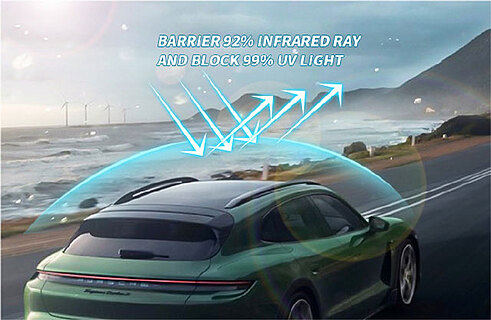Introduction:
When it comes to protecting your vehicle, most drivers focus on paint protection film (PPF) for body panels and tint windows. But what about your sunroof or panoramic glass roof? These large, exposed glass areas are vulnerable to both UV damage and impact stress. UPPF Sunroof Protection Film (SPF) is a next-generation solution designed specifically to shield your sunroof from more than just the sun.
In this blog, we’ll compare UPPF Sunroof Protection Film with standard automotive window tint to help you choose the best option for long-term vehicle protection.

Table of Contents
What is UPPF Sunroof Protection Film (SPF)
UPPF’s Sunroof Protection Film uses a high-performance TPU-based PPF (Polycaprolactone Aliphatic) designed to keep your vehicle cooler and helps with rapid heat dissipation. Embedded with the same advanced PLATICOAT™ top coating as their regular paint protection film (PPF), giving it excellent resistance against:
-Water stains (hydrophobic properties)
-Yellowing (non-yellowing TPU formula)
-Flying debris and hail impact (Self-healing technology)
-Thermal shock and accident proof
Unlike traditional tint, which is thin and designed mainly for glare and heat reduction, UPPF Sunroof Protection Film blocks 99% of harmful UV rays, helping to protect your car’s interior from fading and discoloration while also reducing UV-related skin damage. With a thickness of 8 mil, it offers strong, durable protection against any weather conditions.
Window tint: Great for Heat and Privacy, Not Impact
Automotive window tint - whether dyed, metalized, carbon or ceramic - is designed to:
-Reduce glare and some interior heat
-Protect interiors from UV damage
-Add privacy and improve aesthetics
However, tint is generally much thinner with 1-2 mils thickness, making it ineffective against real-world threats like hailstones, tree branches, or thermal expansion cracks on glass roofs. It is also prone to yellowing and damage in long-term usage.
Automotive window tint - whether dyed, metalized, carbon or ceramic - is designed to:
-Reduce glare and some interior heat
-Protect interiors from UV damage
-Add privacy and improve aesthetics
However, tint is generally much thinner with 1-2 mils thickness, making it ineffective against real-world threats like hailstones, tree branches, or thermal expansion cracks on glass roofs. It is also prone to yellowing and damage in long-term usage.
Keys Differences: UPPF Sunroof Protection Film vs Window Tint
Feature
UPPF Sunroof Film (SPF)
Automotive Window Tint
Material
TPU-based PPF (8mil) (Polycaprolactone
Aliphatic)
Dyed/ceramic film (~1-2 mil)
Impact resistance
Yes
No
UV Protection
High
Moderate-high (ceramic best)
Infrared Ray Rejected
High (93%)
Moderate (depends on tint type)
Thermal Shock Protection
Yes
No
Signal interference
None
Possible (metalized tints)
Feature | UPPF Sunroof Film (SPF) | Automotive Window Tint |
Material | TPU-based PPF (8mil) (Polycaprolactone Aliphatic) | Dyed/ceramic film (~1-2 mil) |
Impact resistance | Yes | No |
UV Protection | High | Moderate-high (ceramic best) |
Infrared Ray Rejected | High (93%) | Moderate (depends on tint type) |
Thermal Shock Protection | Yes | No |
Signal interference | None | Possible (metalized tints) |
Why choose UPPF for your Sunroof?
UPPF is known for its cutting-edge automotive paint protection film, and its Sunroof Protection Film (SPF) is no exception. Here’s why it stands out:
-Engineered for Glass Surfaces: Designed specifically to adhere to sunroof glass, resisting bubbling and peeling over time.
-Hydrophobic and Self-healing: Resists water spots and automatically heals minor scratches when interacting with heat.
-Crystal-clear Appearance: Maintains factory look with optional light tint for glare reduction
-UV and IR Blocking: Helps reduce interior temperature and protects skin and interiors from sun damage.
UPPF is known for its cutting-edge automotive paint protection film, and its Sunroof Protection Film (SPF) is no exception. Here’s why it stands out:
-Engineered for Glass Surfaces: Designed specifically to adhere to sunroof glass, resisting bubbling and peeling over time.
-Hydrophobic and Self-healing: Resists water spots and automatically heals minor scratches when interacting with heat.
-Crystal-clear Appearance: Maintains factory look with optional light tint for glare reduction
-UV and IR Blocking: Helps reduce interior temperature and protects skin and interiors from sun damage.
Sunroof PPF Cost Overview
The cost of applying Paint Protection Film to your sunroof can vary depending on several factors, including the size of the glass, the type of film used, and the complexity of the installation. In most cases, pricing falls within the same general range as partial PPF packages for high-impact areas like hoods or bumpers.
The cost of applying Paint Protection Film to your sunroof can vary depending on several factors, including the size of the glass, the type of film used, and the complexity of the installation. In most cases, pricing falls within the same general range as partial PPF packages for high-impact areas like hoods or bumpers.
Professional installation ensures maximum durability, optical clarity, and proper adhesion, so we always recommend working with an experienced, certified PPF installer. Since prices can vary by location, film brand, and coverage, it’s best to contact a certified UPPF installer near you for an accurate quote tailored to your vehicle.
Professional installation ensures maximum durability, optical clarity, and proper adhesion, so we always recommend working with an experienced, certified PPF installer. Since prices can vary by location, film brand, and coverage, it’s best to contact a certified UPPF installer near you for an accurate quote tailored to your vehicle.
Final thought: Which One Is Right for You?
If your goal is to prevent glare and enhance privacy, certain window tint types are excellent choices. But if you want to protect your sunroof from damage, cracking, shattering, or bubbling/yellowing, UPPF Sunroof Protection Film is no doubt a superior solution.
For drivers with premium vehicles, large glass roofs (like Tesla, BMW, or Mercedes), or those in high-temperature zones, UPPF’s Sunroof Protection Film (SPF) delivers unmatched protection and comfort.
